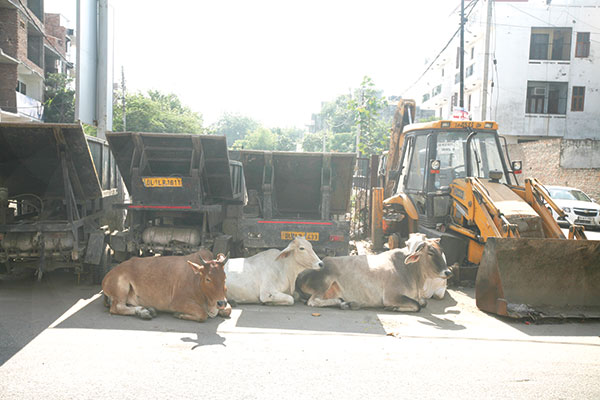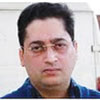The poor animal is useful to raise passions and settle scores. Beyond that, the right wing has done little to reduce its suffering
“Arthashastra jab Dharmashastra ke upar charh baithta hai, tab gauraksha andolan ke neta jooton ki dukaan khol lete hain (When economics prevails over religion, politicians connected with the Save Cow movement open shoe shops).”
--Harishankar Parsai
It was the night of September 28, when the village of Bisarha in Greater Noida woke up to rumours of a family feasting on beef. Without trial, evidence, witnesses, case and without a single hearing, it was jungle raj justice meted out by an unruly mob. Within minutes, the judgment was pronounced and a 50-year-old man named Akhlaq was lynched to death while his son Danish sustained severe head injuries.
Unknown till some hours before, Bisahra became famous in a jiffy. It became a happy hunting ground for opportunist netas, each trying to show the other down in political gimmickry. Politics was at its peak in the village for days together. Instead of trying to cool down tempers and passions of the incident-struck village, trying to derive maximum political mileage seems to be the motto of the netas coming here in big numbers and that too as uninvited guests. After all, all political parties have to see their larger interest – their vote bank.

A lot of hue and cry was raised on the sacredness of the cow and why cow slaughter must not be tolerated. Days on and on, the cow raaga continued. But as they say, news dies very fast and is soon replaced by another news, this news also died its own death, with Bihar assembly elections taking over.
Long ago, there used to be families for whom “gau mata” did really exist. The first roti or chapati made in the kitchen was meant to be given to the cow and only when the cow had eaten it, the family members would have their meal. But gone are the days and traditions have vanished with time.
As per the 2012 animal census, the total cattle population in Uttar Pradesh was just over 1.95 crore. Noida (Gautam Budh Nagar district) has an estimated population of 22,412 of the cow family. Yet, there is not a single government-run gaushala or cow shelter in the entire district – though there is one run by a private body and another private one which is funded by the state government.
READ: This muslim man in Jaisalmer has been serving cows for years
Hundreds of small dairies have come up in the city of Noida. But cattle are meant only for milking purposes. As soon as milking is over, the cow is let loose to roam in the city and eat whatever it gets to eat. The owners of such dairies are working almost on zero running cost, saving at least Rs 300 a day on feed and care of one cow.
Cows roaming on city streets is a common sight and more common sight is cows gathered around garbage dumps, in a desperate bid to satiate their hunger from the waste of households. The cow feeds on these garbage dumps and it either returns to its place on its own or is searched and brought back by the owner later in the day.
The worst part is the plastic or polythene bag consumption which contain the household waste. This plastic proves to be a slow poison for the cow as it does not have sharp canine teeth as cats and dogs do. The cow cannot rip apart the plastic and is forced to swallow the bag along with the contents.
It may take one to three days for the food to pass through the cow’s digestive tract, depending on what the bovine has eaten. The cow’s stomach has four compartments, the rumen, the reticulum, the omasum and the abomasums, each with its own specific duty in digestive process. The rumen is the largest part of the stomach which holds up partly digested food. It contains enzymes that start breaking down hard food and cellulose, starting the digestive process. As the bovine does not have sharp teeth, plastic consumed by it goes and starts collecting in the rumen. The more plastic the cow consumes, the more it collects in the rumen. The plastic later starts hardening in the stomach. As a result, the stomach gets swollen and there comes a time when it cannot eat anything. The animal starts suffering from pain, lies on the ground mashing its teeth and dies a painful death.
Animal rights activist Rukmini Sekhar recalls an operation of the rumen, or rumenotomy, in Puttaparthi of Andhra Pradesh. She says, “Fifty-two kilograms of plastic was taken out and weighed in front of me.” The one word with which she defines the state of cows in India is “pathetic”. She says, “Nowadays cows don’t know what a blade of grass is and they don’t know how to graze.”
To save the cow from the horror, a public interest litigation was filed in the supreme court in 2011, demanding a complete ban on plastic bags. The petitioners included Sekhar, a Puttaparthi-based NGO called karuna society for animals and nature, Philip Bolen, an animal rights activist based in Australia, Pradeep Nath of Vishakapatnam society for prevention to cruelty against animals and a Dutch woman named Clementine. They are represented by senior advocate Shyam Diwan, assisted by Pratap Venugopal. There have been just two hearings in this matter so far and nothing concrete has been achieved in these four years. The litigants do not know what to do next.
The average life span of a cow is 26 years but now it has come down to just eight years. A cow produces milk for two or three years while nursing their calves. In the absence of calves, to keep the milk flowing, cows are artificially inseminated within two months of giving birth, the cow has to give milk while pregnant and after about four pregnancies, it is of no use to the owner.
The old and ‘useless’ animal is sold by its owner. The owner also knows very well that the cow has been sold only to be slaughtered. They say they are sending the cow to ‘Katakpur’ – the local shorthand for a slaughter house.
Rajasthan is the only state in India which boasts of a department dedicated to gaupalan (‘cow affairs’) which is entrusted with the responsibility of welfare and well being of cows. In Jaipur, a shelter called the Hingonia Gaushala is owned and managed by the municipal corporation. But it is in a sorry state of affairs. Forty cows died there every day on average in 2014-15. The situation is getting from bad to worse though there are almost 200 employees on duty there. An equal number of cows are coming here either brought dead or on the verge of dying.
(Repeated efforts to contact the Rajasthan minister of state for gopalan, Ottaram Devasi, proved futile as he did not answer calls.)
Countrywide data shows that the male cattle population has seen a sharp decline of 12.75 percent in five years, from 2007 to 2012, as per the department of animal husbandry. The bulls, as they do not give milk, are an unwanted lot. As compared to the number of cows seen loitering in the city, the number of bulls is much less or rather negligible. Nationwide figures point out the noticeable disproportion with 64.42 percent females and 35.57 percent males.
The gender imbalance is more obvious in figures from Uttar Pradesh. The last animal census of 2012 shows that the number of cow family in the state was 1,95,57,067 of which 1,46,49,923 or 75 percent were cows and 49,07,144 or just 25 percent were bulls. Gautam Budh Nagar had a total cow population of 22,412 (cows: 17,434 or 79.8 percent, bulls: 4,978 or 21.2 percent).
Why is the population of bulls diminishing? Is it that only females are being given birth with artificial insemination or are bulls being sent to butchers and slaughter houses as they are not economically viable for dairies and farmers? If the cow is holy, what about the bull?
Bulls were once useful to plough fields and pull carts, but farmers of western Uttar Pradesh are quite affluent and have turned to tractors.
According to a report, every year over two crore dairy calves are slaughtered around the world for veal or cheap beef. Arguably, drinking milk involves more cruelty than meat does!
Avasthi is a seasoned journalist.
(The story appears in the November 1-15, 2015 issue)

